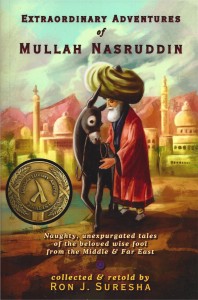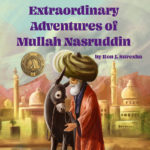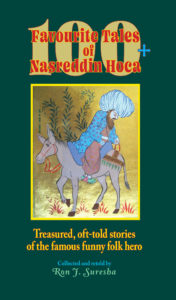Preface, part 2
An excerpt from Extraordinary Adventures of Mullah Nasruddin
Concluded from previous week
While researching the topic of taboo humor I discovered, in The Horn Book by folklore and humor scholar Gershon Legman, his stark condemnation of folk story and joke collections with all the bawdy or “objectionable” material expunged, which he calls “fakelore.” Despite my earnest efforts to locate such risqué stories with limited success, I naturally cringed at the implication that I had unwittingly committed some sort of literary and folkloric misdeed by excluding the naughty and nasty tales of my old friend, Mullah Nasruddin.
Given the immense volume of this character’s folklore, I was perplexed by the conspicuous absence of adult-themed stories among the hundreds I had indexed. The dearth of racy, earthy, profane, or ethnic material in the existing published folklore available to me seemed due in part to its exclusion from popular children’s presentations of the often-moralizing Mullah. My theory was that these “naughty Nasreddin” narratives were expurgated from popular representations of Nasreddin in an effort to “reform” the character, according to the moral codes imposed by both Islamist and Turkish nationalistic influences.
German Nasreddin scholar Ulrich Marzolph’s 1998 analysis, “What Is Folklore Good For?” asserts that “Early Turkish manuscripts comprised a large amount of sexual, scatological, and otherwise disputable material” about the “vigorous and vulgar” Mullah (1998, p. 7). With that concept in mind, I delved even deeper into scholarly texts in search of this taboo material.
Though the character’s Ottoman-Turkish name is Nasreddin Hoca, cognates such as Mullah or Sheikh Nasruddin, Djuha, Joha, Hodja, Abu Nuwas, and so on populate the folklore of many Asian, African, European, and other lands worldwide and share their narratives, so there are diverse cultural sources contributing to this collection. I refer to the character throughout the text as Mullah Nasruddin because that is how I first came to know him.
The most readily accessible bawdy Nasreddin stories employ scatological, ethnic, racial, and sexist humor. Tales involving Nasreddin’s wife and marital affairs are most prevalent, and many feature her as the sexual aggressor. The “young Nasruddin” tales often portray his pubescent sexual explorations and cunning sexual exploitation of women. Sexual stories involving Nasreddin’s donkey make up a third recurring theme. Oddly, storylines with overtly homosexual themes were most difficult to unearth: even putting out a call for such jokes among today’s Istanbul’s gay and bisexual men’s “bear” community yielded no results.
Other critical essays affirmed that these stories existed, although apparently not in contemporary English texts. Turkish scholar Seyfi Karabas observed that “erotic elements in Nasreddin Hoca narratives fulfill several important functions. To begin with, they point to various early stages in the development of Nasreddin Hoca as a trickster figure. Secondly, they serve to create humor in several ways” (p. 303). Aside from the issue of the trickster archetype, it is clear that examples of racy tales existed in the Nasreddin folklore corpus: the question was where.
A breakthrough in my research occurred with a fortunate connection early in 2014 with Hakkı Gűrkaş, a Nasreddin Hoca and Turkish Studies scholar teaching at Kennesaw College in Georgia, U.S.A. In his brilliant, wide-ranging dissertation, he refutes the characterization of Nasreddin as a trickster figure, namely due to the lack of any sort of shape-shifting powers ascribed to him. That point aside, Karabas sagely concludes that “awareness of the importance of sexuality in the life of human beings is one of the more persistent themes that help unify the whole corpus of the Nasreddin Hoca narratives. Hence, Nasreddin Hoca should not be laundered” (p. 305).
But changing social forces of eight hundred years has taken Nasreddin Hoca’s dirty laundry to the river and thrown it religiously against the rocks. This character purification began with linguistic and cultural changes brought in the transition from the Islamic Ottoman era to modern secular Turkish nationalism, and continued through the advent of printing and selective exclusion of objectionable material from published story collections. Over the centuries, Nasreddin “transformed into a charming and subtle philosopher,” according to Marzolph, “whose major preoccupation would be to confront his surroundings with apparently strange questions or unconventional solutions to common problems” (p. 7).
Gűrkaş explains the significance of the censored material: “These stories bring back into discourse what the official culture has marginalized and repressed. These stories are anti-hegemonic. The grotesque imagery deployed in these stories mocks and ridicules the absolutist morality and degrades the official culture that relies on it” (p. 178).
In the spirit of intellectual freedom and restoration of the adulterated folklore, presented here are more than 265 authentic Nasreddin Hoca stories, many of which appear here in an English trade publication for the first time. From the first volume, I rewrote over a dozen tales, according to verified alternate sources: for instance, the long tale “Four brays of the donkey” here is “Four farts”; this version of “God’s arrears to Nasruddin” has a Jewish protagonist; the sexual overtones in “The hens in the hammam” here are stated more fully. Some stories are not particularly naughty, but come from reliable sources newly available and are worth including here among the first and final sections of the Mullah’s adventures.
All narratives herein are based on published texts listed in the Sources; none of the tales presented in this or the first collection are my original or creative invention. Whenever multiple tellings of a joke or anecdote were available, they were incorporated into this work. However, for some stories I had to rely on a translation of one or two versions and my ability to interpret its cultural context and narrative arc. I have tried to convey the bawdy wit and folk wisdom of the Mullah as may have been presented and received, centuries ago, halfway around the world, by the original storytellers and listeners.
As in the previous collection, here I employ the literary device of naming the Mullah’s family, friends, neighbors, and donkey as a way to situate him in his community. Readers may take issue with the intensity and frequency of the colloquial profanity and slang invective in some dialogue; the foul language, however, is comparable to that as translated from authentic sources, albeit adapted to contemporary usage.
As exhaustive as this work may have been, this sequel and its predecessor do not represent the entire Nasreddin corpus. There are dozens of stories untranslatable from Turkish, German, Arabic, and other languages that remain inaccessible in English. Additionally, a handful of stories effectively translated, but requiring overlong cultural, religious, or wordplay explanations, must be left for another’s work.
This collection leads with “The learned and the ignorant,” a tale that proclaims its moral imperative, “Those who know should teach those who don’t know,” which represents a common creed of folklore and literature. In researching, collecting, translating, and publishing these stories, I have acquired not only the authority to disseminate the work but also a keen sense of duty. For far too long the social forces that repress sexual and other “undesirable” story elements have hidden this cache of some of the most amusing, witty, and outrageous folklore in the world.
I close this introduction with the words of the great American poet, Walt Whitman: “The dirtiest book of all is the expurgated book.” Doubtless the Mullah would agree.
Works cited
Gűrkaş, Hakkı. Nasreddin Hodja and the Akşehir Festival: Invention of a Festive Tradition and Transfigurations of a Trickster, from Bukhara to Brussels. Ph.D dissertation. West Lafayette, Ind.: Purdue University, 2008.
Karabas, Seyfi. “The Use of Eroticism in Nasreddin Hoca Anecdotes.” Western Folklore 49: 3 (July 1990), pp. 299–305. Long Beach, Calif.: Western States Folklore Society.
Legman, Gershon. The Horn Book: Studies in Erotic Folklore and Bibliography. New Hyde Park, N.Y.: University Books, 1964.
Marzolph, Ulrich. What Is Folklore Good For? On dealing with undesirable cultural expression. Journal of Folklore Research, 35: 1 (Jan.–Apr. 1998), pp. 5–16.
Whitman, Walt. Leaves of Grass. New York: New American Library, 1980.




